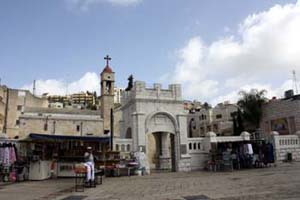
A Visit To Jesus’ Hometown
by Troy Herrick
Present-day Nazareth looks nothing like when it’s most famous son, Jesus, lived here. There are no Christmas-card-like scenes of pastoral churches, camel caravans, shepherds and grazing sheep. What you find now is a maze of narrow, winding cobblestone lanes and a population two thirds Muslim and one third Christian. Nothing from those early days remains except for sites that are “traditionally” associated with Christ and his family. The majority of these are now ruins housed within churches so you require some imagination to put them into perspective.
Fortunately you will not have to stretch your imagination too much if you divide your Nazareth daytrip into two parts. Start with a visit to Nazareth Village, a reconstructed 1st Century AD village where actors are dressed in period costume, and experience life as it was almost 2000 years ago. Next, visit the traditional sites associated with Jesus and his family in the old city.
Nazareth Village
 Rani our tour guide opened a door and ushered us out onto the grounds of Nazareth Village, a reconstruction of Jesus’ old neighbourhood. As he did so, I suddenly remembered that Rod Serling began every episode of the Twilight Zone with “you unlock this door with the key of imagination”. We knew that we had arrived in the past when we were almost bowled over by an oncoming shepherd and his five sheep. With very little effort he ushered his flock into a circular pen constructed of standing sticks. My second thought was to watch where I stepped, just in case.
Rani our tour guide opened a door and ushered us out onto the grounds of Nazareth Village, a reconstruction of Jesus’ old neighbourhood. As he did so, I suddenly remembered that Rod Serling began every episode of the Twilight Zone with “you unlock this door with the key of imagination”. We knew that we had arrived in the past when we were almost bowled over by an oncoming shepherd and his five sheep. With very little effort he ushered his flock into a circular pen constructed of standing sticks. My second thought was to watch where I stepped, just in case.
This property was a working vineyard during the time of Jesus. Rani brought our group to the original 1st century CE wine press where we were invited to step inside and pretend to crush grapes for a new batch of Chateau La Feet. A watch tower in the vineyard suggests that all was not secure during that period of Roman occupation.
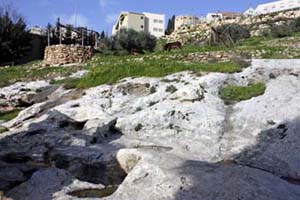 A short distance away, seated outside the doorway of her stone house, a middle-aged woman sits and spins wool by means of a hand spindle. As some of the tour group found out, it is a great deal more difficult than it looks. Our guide outlines the steps required to process and dye the wool with natural colours from pomegranate and onion skin before it is woven into a garment.
A short distance away, seated outside the doorway of her stone house, a middle-aged woman sits and spins wool by means of a hand spindle. As some of the tour group found out, it is a great deal more difficult than it looks. Our guide outlines the steps required to process and dye the wool with natural colours from pomegranate and onion skin before it is woven into a garment.
Moving along we visited a carpenter’s shop where an elderly man was teaching a young boy how to assemble a manger. Together they were chiselling a rectangular hole into a small log. The elderly actor demonstrated how to operate a hand drill using a bow – the same principle as starting a fire by rubbing two sticks together. You can easily envision a young Jesus being taught the carpenter’s trade from his father.
T he young Jesus would have also attended school. In those days, the local synagogue served as the community school. We entered the house of worship to find three tiers of benches lining the greyish-white walls; a wooden bench at the centre of the room held the Torah Scroll. This synagogue and all other building were reconstructed by referencing the best New Testament and archaeological sources available.
he young Jesus would have also attended school. In those days, the local synagogue served as the community school. We entered the house of worship to find three tiers of benches lining the greyish-white walls; a wooden bench at the centre of the room held the Torah Scroll. This synagogue and all other building were reconstructed by referencing the best New Testament and archaeological sources available.
Our visit into Nazareth’s past complete, we returned to the 21st century. Now Diane and I were in the right frame of mind to visit the traditional sites associated with Jesus and his family, most of which were within walking distance in the old city.
The Old City
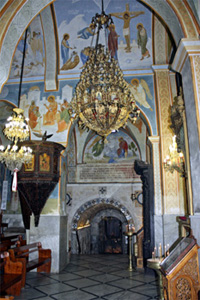 Present day Nazareth is a bustling city of approximately 70,000 people, a far cry from the 400 or so people living here at the time of Jesus. Work your way north along traffic-clogged Paulus VI Street and be thankful that you are not driving. Your first destination is St. Gabriel’s Church, the most distant site.
Present day Nazareth is a bustling city of approximately 70,000 people, a far cry from the 400 or so people living here at the time of Jesus. Work your way north along traffic-clogged Paulus VI Street and be thankful that you are not driving. Your first destination is St. Gabriel’s Church, the most distant site.
St. Gabriel’s Church is the traditional Greek Orthodox site of the Annunciation where the Angel Gabriel visited Mary to announce the birth of Jesus (Luke 1:26-35). This church was constructed over the only natural water source in Nazareth. This site was chosen because the non-canonical Protoevangelium of James (verse 11) indicated that Mary went to fill a pitcher with water. It should be noted that some houses of this period had water cisterns.
Enter the church and descend the staircase to a dimly lit man-made grotto housing a small stone well. The water is potable so you may wish to take this opportunity to fill up your water bottle if you have one. Water doesn’t get healthier and holier than this. After refreshing yourself, return to the nave upstairs and admire the brightly painted New Testament scenes covering the arched ceiling before you exit.
Downhill and to the right, you find a white stone structure known as Mary’s Well. This structure was likely built to provide Nazareth residents with ready access to fresh water even though the actual source remains within the crypt of St. Gabriel’s Church.
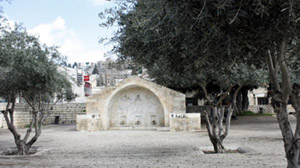 Retracing your steps along Paulus VI Street, turn right onto Casa Nova Street and arrive at the Roman Catholic Basilica of the Annunciation – the largest church in the Middle East. This church was built over the Grotto of the Annunciation, an ancient cave dwelling, traditionally accepted as being Mary’s home when she was visited by the Angel Gabriel. I could find no scriptural reference suggesting Mary lived in such a structure however.
Retracing your steps along Paulus VI Street, turn right onto Casa Nova Street and arrive at the Roman Catholic Basilica of the Annunciation – the largest church in the Middle East. This church was built over the Grotto of the Annunciation, an ancient cave dwelling, traditionally accepted as being Mary’s home when she was visited by the Angel Gabriel. I could find no scriptural reference suggesting Mary lived in such a structure however.
Entering the basilica via the bronze-covered doors depicting scenes from the life of Christ, you find yourself in the crypt or lower church. Your eyes are immediately drawn to the white limestone grotto behind the high altar. Part of this grotto is natural and part is man-made; the latter consists of remnants of earlier church structures from the Byzantine and Crusader eras. The cave in turn houses its own small altar.
 Above the grotto structure you find a large octagonal opening in the ceiling providing you with a view of the upper church. The dark brown cupola of the upper church roof is also visible, extending to a dizzying height of 60 meters. The ribs of the cupola represent the petals of an upside-down lily, symbolic of Mary’s purity. To visit the upper church, ascend the staircase just inside the doorway of the lower church.
Above the grotto structure you find a large octagonal opening in the ceiling providing you with a view of the upper church. The dark brown cupola of the upper church roof is also visible, extending to a dizzying height of 60 meters. The ribs of the cupola represent the petals of an upside-down lily, symbolic of Mary’s purity. To visit the upper church, ascend the staircase just inside the doorway of the lower church.
Arriving at the upper church, you are surrounded by a series of international mosaics and icons all depicting Madonna and Child. More of these mosaics line the portico outside which you can tour before making your way to the Church of St. Joseph on the same property.
 Christian tradition dating to the 7th century CE has it that Joseph’s house and carpenter shop were located on the site of the present Church of St. Joseph. Inside, the bare stone crypt features several rock-hewn chambers, a cistern and several silos for storing grain. A mosaic floor dates from Byzantine times. The nearby side chapel marks the spot where Joseph was visited by an angel as he slept (Matthew 1:20).
Christian tradition dating to the 7th century CE has it that Joseph’s house and carpenter shop were located on the site of the present Church of St. Joseph. Inside, the bare stone crypt features several rock-hewn chambers, a cistern and several silos for storing grain. A mosaic floor dates from Byzantine times. The nearby side chapel marks the spot where Joseph was visited by an angel as he slept (Matthew 1:20).
Leaving the church property, your next destination is the Greek Catholic Synagogue Church. But first you must enter the exotic Arab market (souk). Walk along Casa Nova Street and follow the smell of freshly ground Turkish coffee. As you pass through the narrow streets, stick your nose inside some of the shops and look for that perfect souvenir. En route, don’t be shy about asking for directions to the Greek Catholic Synagogue Church.
The Greek Catholic Synagogue Church occupies the site of the earlier Nazareth synagogue where Jesus taught (Luke 4:16). The honey brown limestone interior features a stone-vaulted roof and an altar set on a two-tiered platform. A picture of Jesus preaching in the synagogue hangs behind the altar. The congregation seems so peaceful and attentive; a far cry from the angry mob that would escort Jesus to the Mount of the Precipice. He was to be thrown to his death from the cliff as punishment for his blasphemy in announcing the fulfillment of Isaiah’s prophecy (Luke 4:29).
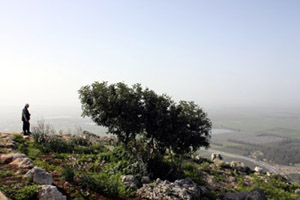 The Mount of the Precipice, 297 meters high, is now a park. From a lookout at the summit, you have a panoramic view of the surrounding area including distant Mount Tabor – the traditional site of the Transfiguration. But that journey will have to wait for another day. Instead you may wish to enjoy a leisurely stroll along the gravel path at the cliff’s edge and contemplate the meaning of your daytrip. As you take in the scenery, the essence of Jesus seems closer even though almost 2000 years have passed since he resided in his hometown of Nazareth.
The Mount of the Precipice, 297 meters high, is now a park. From a lookout at the summit, you have a panoramic view of the surrounding area including distant Mount Tabor – the traditional site of the Transfiguration. But that journey will have to wait for another day. Instead you may wish to enjoy a leisurely stroll along the gravel path at the cliff’s edge and contemplate the meaning of your daytrip. As you take in the scenery, the essence of Jesus seems closer even though almost 2000 years have passed since he resided in his hometown of Nazareth.
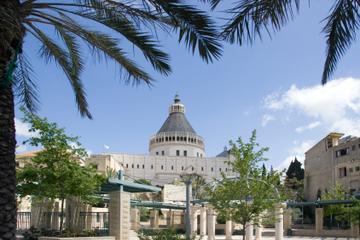
Private Tour: Nazareth, Tiberias and Sea of Galilee Day Trip from Tel Aviv
If You Go:
♦ To get to Nazareth Village, travel south on Paulus VI Street and turn right onto al-Wadi al-Jawani St. Follow the sign (there is only one so don’t miss it) at the intersection directing you to the YMCA which is next to Nazareth Village. Admission is 50 Shekels for a guided tour. www.nazarethvillage.com
♦ Parking is expensive in Nazareth. If you arrive by car, leave it at Nazareth Village where parking is free. All of the sites in the old city are within walking distance from here.
♦ Admission to all sites in the old city is free.
♦ To get to the Basilica of the Annunciation from Nazareth Village, walk out to Paulus VI Street and then walk north to the intersection of Paulus VI and Casa Nova Streets. The entrance is on Casa Nova Street.
♦ The Church of St. Joseph is approximately 90 meters from the Basilica of the Annunciation.
♦ The Greek Catholic Synagogue Church is located in the souk at 6120 Street. Note that many of the lesser streets in the city have no names; they are only numbered.
♦ St. Gabriel’s Church and Mary’s Well are approximately one kilometre north of the Basilica of the Annunciation.
♦ The Mount of the Precipice is outside the old city and you require a car to get there. Exit the Nazareth Village parking lot and turn right onto Paulus VI Street. Follow this street until it meets with Haifa Road then turn left. Drive up the windy road to the top of the mountain.
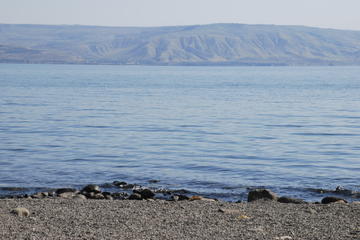
2-Day Israel Tour from Tel Aviv: Acre, Caesarea, Nazareth and the Sea of Galilee
About the author:
Troy Herrick, a freelance travel writer, has traveled extensively in North America, the Caribbean, Europe and parts of South America. His articles have appeared in Live Life Travel, International Living, Offbeat Travel and Travels Thru History Magazines. He also penned the travel planning e-book entitled ”Turn Your Dream Vacation into Reality: A Game Plan for Seeing the World the Way You Want to See It” – www.thebudgettravelstore.com/page/76972202 based on his own travel experiences over the years. Plan your vacation at his website www.plan-a-dream-trip.com
Photo credits:
All photographs are by Diane Gagnon, a freelance photographer who has traveled extensively in North America, the Caribbean, Europe and parts of South America. Her photographs have accompanied Troy Herrick’s articles in Live Life Travel, Offbeat Travel and Travels Thru History Magazines.


